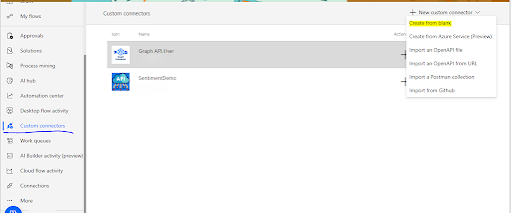Part 1: Creating Code Apps in Power Apps - A step-by-step guide (with real errors I faced & how I fixed them)
Intro
In this post I’ll walk you through how I set up a code-based app for Power Apps (React/Vite front-end + Power Platform CLI for packaging/deployment), the exact errors I ran into, and how I solved them. If you want a hands-on, copy-paste able guide that covers Node versions, pac auth, environment issues, and packaging tips, this is for you.
Prerequisites
-
Microsoft 365 account with access to a Power Platform environment
-
Node.js (20.19+ recommended LTS)
-
VS Code
Install power platform tools extension in VS Code.
Steps:
Step 1: Open Visual Studio Code and launch the integrated terminal.
Step 2: In the terminal, run the following commands one by one.
mkdir D:\CodeApps -Force
cd D:\CodeApps npm create vite@latest myfirstapp -- --template react-ts cd D:\CodeApps\myfirstapp npm install
Initially, I ran the command:
npm create vite@latest MyFirstApp -- --template react-ts
This gave the error:
Invalid package.json name
The issue was caused because package.json names must be lowercase. After changing MyFirstApp to myfirstapp, the issue was resolved.
Step 3: Install the Node.js type definitions by running the command:
npm i --save-dev @types/node
Step 4: Open the vite.config.ts file and update it as follows:
import { defineConfig } from 'vite'
import react from '@vitejs/plugin-react'
import * as path from 'path'
// https://vite.dev/config/
export default defineConfig({
base: "./",
server: {
host: "::",
port: 3000,
},
plugins: [react()],
resolve: {
alias: {
"@": path.resolve(__dirname, "./src"),
},
},
});
save the file.
Step 5: Test your Vite app by running the command:
npm run dev
This will start the template project locally.
Open your browser and navigate to http://localhost:3000
to see the app running.
Once you’ve confirmed it’s working, press Ctrl + C in the terminal to stop the local server.
Step 6: Initialize your Code App
To authenticate the Power Platform CLI against your Power Platform tenant, run:
pac auth create
You will be prompted to log in with your Power Platform account.
In my case, this command opened a blank popup screen and did not work.
If you face the same issue, use the alternative command:
pac auth create --deviceCode
After running this, you’ll see a message like:
To sign in, use a web browser to open the page https://microsoft.com/devicelogin
and enter the code 123ABCDE to authenticate.
Now, open the URL in your browser, enter the code, and sign in with your account to complete the authentication.
Step 7: Select Your Environment
Run the following command to select your target environment:
pac env select -env <URL of your environment>
You can find the environment URL by following these steps:
Open make.powerapps.com
Go to Settings (⚙️)
Click Session details
Copy the Instance URL and paste it into the command.
Step 8: Initialize Your Code App
Run the following command to initialize your Code App:
pac code init --displayName myfirstapp
After running this, you will see a new file created in your project:
-power.config.json → This file contains the configuration details for your Code App.
Step 9: Install the Power SDK using:
npm install --save-dev "@pa-client/power-code-sdk@https://github.com/microsoft/PowerAppsCodeApps/releases/download/v0.0.4/7-31-pa-client-power-code-sdk-0.0.1.tgz"
Step 10: Open the package.json, and update the existing line:
"dev": "vite"
to be:
"dev": "start pac code run && vite",
Save the updated pacakage.json.
Step 11: Add a new file under the src folder named PowerProvider.tsx and add the below code.
import { initialize } from "@pa-client/power-code-sdk/lib/Lifecycle";
import { useEffect, type ReactNode } from "react";
interface PowerProviderProps {
children: ReactNode;
}
export default function PowerProvider({ children }: PowerProviderProps) {
useEffect(() => {
const initApp = async () => {
try {
await initialize();
console.log('Power Platform SDK initialized successfully');
} catch (error) {
console.error('Failed to initialize Power Platform SDK:', error);
}
};
initApp();
}, []);
return <>{children}</>;
}
Save the file.
Step 12: Open main.tsx and add the following import under the existing imports:
import PowerProvider from './PowerProvider.tsx'
Step 13: Update main.tsx
<StrictMode>
<App />
</StrictMode>,
to be
<StrictMode>
<PowerProvider>
<App />
</PowerProvider>
</StrictMode>,
Save the file
npm run dev
This will run the vite server, but also start the Power SDK server:
Open the URL provided by the Power SDK Server. Important: Open the url in the same browser profile as your power platform tenant.
You should see the app open similar to:
Step 15: Publish the App to Your Power Apps Environment
To publish your app, first build the project with:
npm run build
Then push it to your Power Apps environment using:
pac code push
When I ran this, I encountered the following error:
Error: There was an error in pushing the app: bolt.authentication.http.AuthenticatedClientException:
The environment '12b12ada-c234-e123-b84f-e123123' in tenant 'bd4a9f7e-t52e-4123-4312-432d123123we'
does not allow this operation for this Code app 'n34cd6bc-12a0-3x23-834f-72343efd5688'.
Please reach out to your environment admin to enable Code app operations.
This means that Code app operations are disabled in the selected environment.
To fix this, the environment administrator must enable the feature in the Power Platform Admin Center.
First you need to turn on this feature.
Go to Power Platform Admin center> Manage > Environment > Click On Settings > expand product
pac code push
you might still get the same error.
If that happens, remove your authentication profile and re-authenticate.
Step 16:
Finally, run the following command to publish your app to the selected Power Apps environment:
pac code push
This will successfully push your code app into the environment, making it available inside Power Apps.














👌
ReplyDelete👌
ReplyDeleteThank you for sharing this
ReplyDeleteThis guide was incredibly helpful! Thank you so much!
ReplyDelete